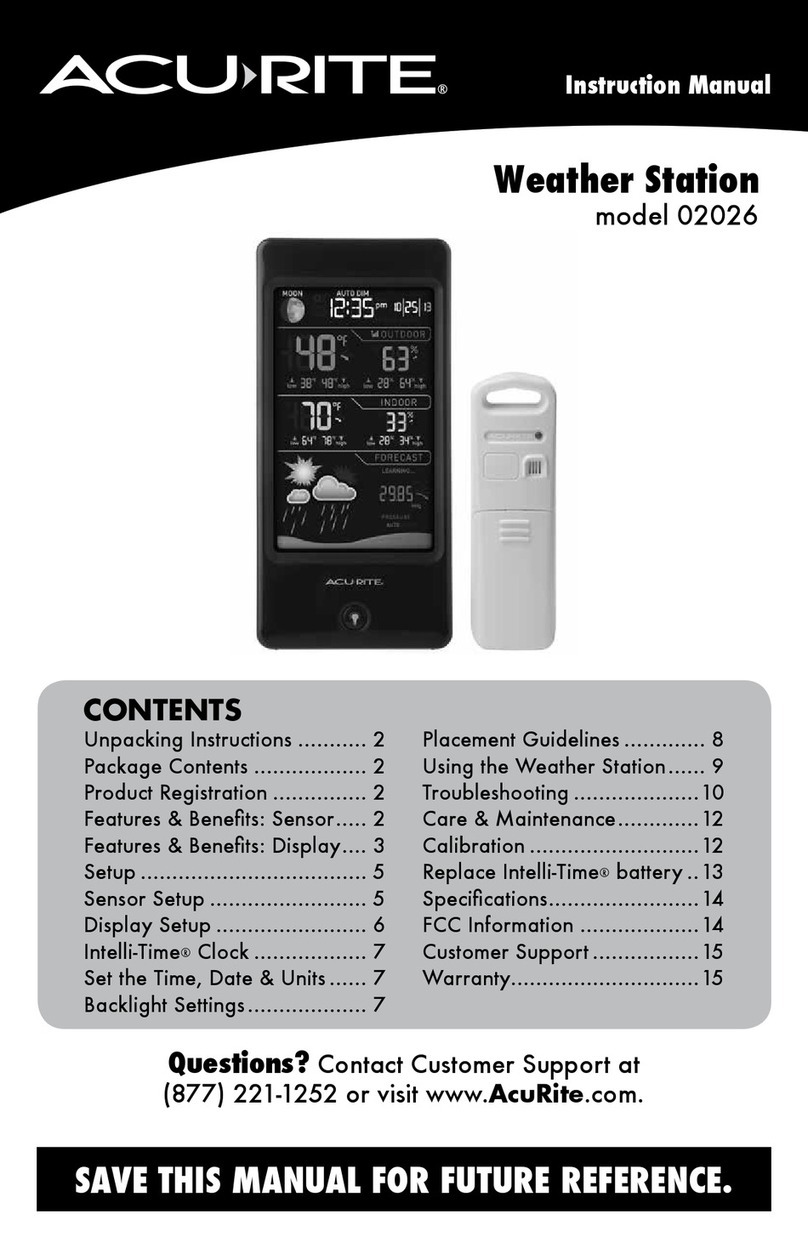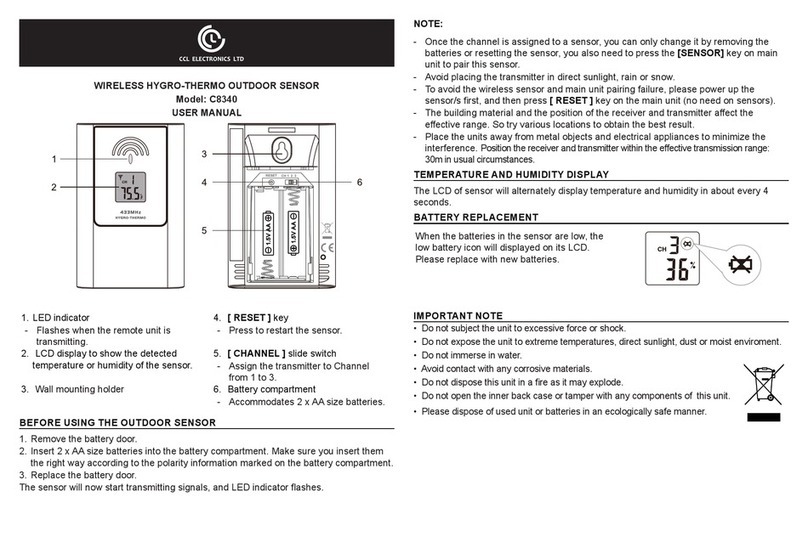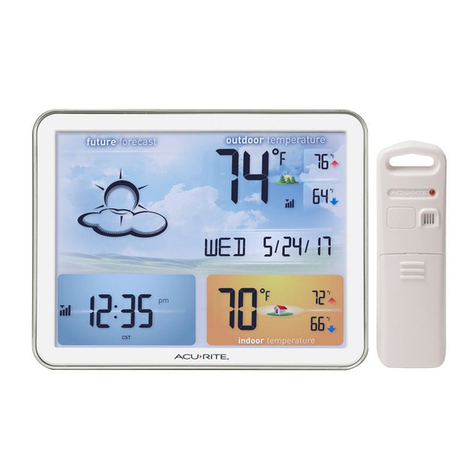Shuanghe SH8045A User manual

A 2
A 3A 4
A 5
A 6
A 7
A 8
A 9
A 10
A 11
A1:
A8:
Weather forecast symbols
MAX and MIN temperature
and humidity
A2:
A9:
Time/Alarm/Date
Indoor temperature
A3:
A10:
Air pressure
Indoor low power index
A4:
A11:
RCC symbol
Outdoor temperature
A5:
A12:
Moon phase
Outdoor low power index
A6:
A13:
Alarm icon
Channel number & RF
symbol
A7: Indoor humidity
A 1
A 13
A 12
WIRELESS WEATHER STATION
Instruction manual
Model:SH8045A
1.Description of parts
Fig. 1: Receiver front side
-1-

B1
B2
B3 B5
Fig. 2: Receiver backside
B6
B4
B1: Buttons
Hanging hole
B2:
B3:
5V micro usb input
B4:
RESET button
B5: B6:
Support Battery door
-2-

Fig. 3
C1: Wall mounting hole
C2: Battery compartment
(screwed)
C3: Switch 1-2-3 for channel
selection
C4: TX button
Fig. 3: Transmitter
C 1
C 2
C 4
C 3
2. Before you start using it
• Please make sure to read the instruction manual carefully.
This information will help you to familiarise yourself with your new device, to learn all of its functions
and parts, to find out important details about its first use and how to operate it and to get advice in
the event of a malfunction.
• Following and respecting the instructions in your manual will prevent damage to your instrument and
loss of your statutory rights arising from defects due to incorrect use.
-3-

• We shall not be liable for any damage occurring as a result of non following of these instructions.
Likewise,we take no responsibility for any incorrect readings and for any consequences which may
result from them.
• Please take particular note of the safety advice!
• Please keep this instruction manual for future reference.
3.Scope of delivery
• Wireless weather station (Receiver)
• Micro USB wire
• Outdoor transmitter (CH1)
• Instruction manual
4.Specifications
• Measuring range indoors:Temperature -10°C~+50°C(14°F~122°F) Humidity 20%~95%.
• Measuring range outdoors: Temperature -40°C~+60°C(-40°F~140°F).
• Accuracy:Temperature +/-1°C(2°F) between 0°C to 50°C,otherwise +/-2°C(4°F).
Humidity +/-5% between 30% to 70%,otherwise +/-8%.
• Working temperature and humidity : -10°C~+50°C (14°F~122°F) and 20%~95%.
• Storage temperature and humidity : -10°C~+60°C (14°F~140°F) and 10%~95%.
• Power Consumption: Receiver 2 X 1,5V AAA(not include) or 5V/1A micro usb input.
Transmitter 2 X 1,5V AAA(not include).
• RCC function: DCF and WWVB choice.
• Air pressure measuring, unit HPA in DCF mode and unit INHG in WWVB mode.
• Transmission distance: 60m in free field.
• Transmission frequency:433MHZ.
-4-

• This product is exclusively intended for the field of application described above. It should only be used
as described within these instructions.
5. For your safety
• Unauthorized repairs, modifications or changes to the product are prohibited.
• Transmission time: CH1:50 seconds CH2:53 seconds CH3:56 seconds.
• Weather forecast:sunny,partly cloudy,cloudy,rainy,stormy.
• Time date display.
• Two alarm function.
• Moon phase display.
-5-
Caution!
Risk of injury:
• Keep these instruments and the batteries out of the reach of children.
• Batteries must not be thrown into a fire, short-circuited, taken apart or recharged. Risk of explosion!
• Batteries contain harmful acids. Low batteries should be changed as soon as possible to prevent
damage caused by leaking.
• Never use a combination of old and new batteries together, nor batteries of different types.
• Wear chemical-resistant protective gloves and safety glasses when handling leaking batteries.
!
Important information on product safety!
• Do not place your device near extreme temperatures, vibrations or shocks.
• Protect it from moisture.
• The outdoor transmitter is protected against splash water, but is not watertight. Choose a shady and
dry position for the outdoor transmitter.
!

• Place both instruments on a desk with a distance of approximately 1.5 meter. Avoid getting close to
possible interference sources (Electronic devices and radio installations).
• Remove the protective foil from the display of the receiver.
• Connect the basic station to the attached micro-usb wire,and put USB port into 5V/1A power part,like
computer,the charger of phone,etc. (This way the backlight will be light all time.)
6.1 Inserting the batteries in the receiver
6. Getting started
-6-
• Or remove the battery cover and insert two new batteries 1,5V AAA,polarity as illustrated,Close the
battery compartment again. (This way the backlight will be not light all the time, it need press button to
turn on the backlight,and the backlight will light few seconds then auto turn off.)
• The device will alert you with a beep and all LCD segments will be displayed for a short moment.
• The default:
TIME:2019-1-1, 0:00; AL1: 6:00, OFF ; AL2: 0:00, OFF
Hour system: 24hr; Temperature unit: °C;
• The pressure is blinking,press or to adjust the value,press “SET” to confirm and quit;
if no button pressed,then after 20s it will be auto quit the setting and go to RF search.
• Open the screwed battery compartment of the outdoor transmitter.
• The slide switch for channel selection is at position 1 (default).
• Insert two new batteries 1,5 V AAA, polarity as illustrated.
• Close the battery compartment again.
6.2 Inserting the batteries in the outdoor transmitter

• The outdoor values of the outdoor transmitter will be transmitted to the receiver. The displays of the
outdoor values are flashing "--.-".
• On the display of the receiver appear the channel number, the outdoor temperature in °C (default).
• If receiver receive the signal,it will display the current temperature of transmitter in OUT position.
• If the reception of the outdoor values fails within three minutes, "- -"appears on the display. Check the
batteries of the transmitter and try it again. Check if there is any source of interference.
• You can also start the outdoor transmitter search manually later on (for example when the outdoor
transmitter is lost or the batteries are changed).
• Hold the button on the receiver for three seconds, "---" blinking on the display.
• Press the TX button in the battery compartment of the outdoor transmitter.
• The device will alert you with a beep and the receiver receives the values from the outdoor transmitter.
6.2.1 Reception of the outdoor values
-7-
• After successful installation close the battery compartment of the outdoor transmitter carefully.
6.3 Reception of the DCF frequency signal
• After the reception of the outdoor values, the device will now scan the DCF frequency signal and
the DCF symbol will be flashing on the display.
• To avoid interference, the other buttons (except ) will no function during the reception
of the radio controlled clock.
• When the time code is received successfully after 2-12 minutes, the radio-controlled time and the
DCF symbol are displayed steadily in the display. The other buttons are activated permanently.
• You can start the initialization manually.
• Press and hold the button for 3 seconds. The DCF symbol will be flashing.
• Interrupt the reception by pressing the button again. The DCF symbol disappears.

just tower - RCC function ON
no reception
There are four different reception symbols:
flashing - reception is active stays - reception is very good
• If the clock cannot detect the DCF-signal (for example due to disturbances, transmitting distance,
etc.),the time can be set manually. The DCF symbol disappears and the clock will then work as a
normal quartz clock.(see: Manual settings).
• If do not need DCF,it can turn off the function.(see:Manual settings).
no symbol - RCC function OFF
time is manually set
-8-
• The DCF reception always takes place hourly between 2:00 and 5:00 o'clock in the morning. If the
reception is not successfully received until 5:00 o'clock, the next receive operation is again at 2:00
o'clock in the morning.
The time base for the radio-controlled time is a caesium atomic clock operated by the Physikalisch
Technische Bundesanstalt Braunschweig.It has a time deviation of less than one second in one million
years. The time is coded and transmitted from Mainflingen near Frankfurt via frequency signal DCF-77
(77.5 kHz)and has a transmitting range of approximately 1,500 km.Your radio-controlled clock receives
this signal and converts it to show the precise time. Changeover from summer time or winter time is
automatic. In Daylight Saving Time "DST" is shown on the LCD. The quality of the reception depends
mainly on the geographic location. Normally there should be no reception problems within a 1,500 km
radius around Frankfurt.
6.3.1 Note for radio-controlled time DCF

Please take note of the following:
• The recommended distance to any interfering sources like computer monitors or TV sets at least
1.5-2 meters.
• Inside ferro-concrete rooms (basements,superstructures),the received signal is naturally weakened.
In extreme cases, please place the unit close to a window to improve the reception.
• During night-time, the atmospheric interference is usually less severe and reception is possible in
most cases.A single daily reception is adequate to keep the accuracy deviation under 1 second.
• During the operation, all successful settings will be confirmed by a brief beep tone.
• The device will automatically quit the setting mode if no button is pressed for a long period of time.
• Press and hold the or button in the setting mode for fast running.
7.1 Manual settings
7. Operation
SET
AL SET
• Hold the button in normal mode for three seconds, to enter the setting mode.
• The setting sequence is shown as follows: Time Zone - 12 or 24 hours system (24H default)
- Hour - Minute - Year - Month - Day - Language of week.
-9-
• Press the or button to increase or decrease for setting.
• Press and hold the or button for fast running.
• Confirm the setting with the button or no button pressed in 15 seconds.
• The manually set time will be overwritten by the DCF time when the signal is received successfully.
SET
AL SET
7.1.1 Setting of the time zone
• In the setting mode you can make the time zone correction (-1 , 0 , +1).
• The time zone correction is needed for countries where the DCF signal can be received.

7.1.2 Setting of the 12 and 24 hours display
• In the setting mode you can choose between the 12 - and 24 hour system.
• In the 12 HR system AM or PM (after 12 o'clock) appears on the display.
7.2 Setting of the alarm time
7.1.3 Snooze time setting
• In the setting mode you can set the snooze time from 5 min to 60 min.
• Press the button into ALARM mode, “A1” words displayed,and 6:00 AM default.press again
"A2" words displayed, and 0:00 AM default.
• When display “A1” or “A2” ,hold the button for 3 seconds to set alarm time.
• The setting sequence is shown as follows: Hour - Minute.
• Press the or button to increase or decrease for setting.
• Press and hold the or button for fast running.
• Confirm the setting with the button or no button pressed in 15 seconds.
• Press button to turn on or off alarm function.
• When the icon or of alarm is diaplayed, it means that alarm function is turn on.
• : Alarm 1 , :Alarm 2.
SET
AL SET
SET
AL SET
SET
AL SET
12
12
-10-
7.4 Display of pressure
• In the normal mode hold button for 3 seconds,it can switch the unit pressure.
• Unit of pressure “ HPA ” and “INHG”.
MEM
inHG·hPa
7.3 Backlight
•Attention: Backlight in continuous operation only works with USB power connected.
• Press any button to turn on backlight for 8 seconds when use battery.

8. Micro-USB input
• 5V/1A power can input from Micro-USB part on the left side.
• The weather station has five different weather symbols(sunny,slightly cloudy,cloudy,rainy and stormy).
• The weather forecast relates to a range of 12 hours and indicates only a general weather trend. The
accuracy is about 70 %.
• For example, if the current weather is cloudy and the rain symbol is displayed, it does not mean the
product is faulty because it is not raining. It simply means that the air pressure has dropped and the
weather is expected to get worse but not necessarily rainy. The accuracy is about 70 to 75%.
• The sun symbol also appears at night if there is a starry night.
9. Weather forecast symbols
-11-
sunny partly cloudy cloudy rainy stormy
Fig. 4
Please note that the forecast symbol will become more defined in the course of operation. The forecast
symbol is active right from the start, however, the reliability of the forecasts increases with the amount
of data collected. The sensor must adapt initially to the reference level at the site.
Note:

10. Thermometer and hygrometer
10.1 Maximum/Minimum function
• If the measure values above the range,then temperature display "HH.H",humidity display "HH%".
• If the measure values below the range,then temperature display "LL.L",humidity display "LL%".
• Press the button in normal mode.
• MAX appears on the display.
• You can now get the highest values for the indoor temperature and humidity and outdoor temperature
since the last reset.
• Press the button again.
MEM
inHG·hPa
MEM
inHG·hPa
-12-
• MIN appears on the display.
• You can now get the lowest values for the indoor temperature and humidity and outdoor temperature
since the last reset.
• Press the button once more, to go back to the present values display.
• The device will automatically quit the MAX/MIN mode if no button is pressed.
• Press and hold the button for two seconds while the maximum or minimum values are displayed
to clear the recorded readings.
MEM
inHG·hPa
MEM
inHG·hPa
10.2 Setting of the temperature unit
•
In the normal mode you can change between ° C (Celsius) or ° F (Fahrenheit) as temperature unit.
•
Press the button.

11. Moon phase
Waxing Crescent
Moon
Quarter Moon
Waxing Gibbous
Moon
Full Moon
Waning Gibbous
Moon
Last Quarter
Moon Waning Crescent
Moon
New Moon
• The moon phase auto change according the date.
-13-

• For having more than one additional outdoor transmitter select with the 1/2/3 switch in the battery
compartment of the outdoor transmitter for each single outdoor transmitter a different channel. The
reception of the new transmitter will be transmitted automatically to the receiver. Press and hold the
button on the receiver or restart the receiver according to the manual.
• The outdoor values will be shown on the display of the receiver. If you have installed more than one
outdoor transmitter, press the button on the receiver to change between the channels 1 to 3.
• You can also choose an alternating channel display. After the third channel, press the button
again, the numbers and temperature value of each channel will cycle display .
• Press the button again to deactivate the alternating channel and the first outdoor transmitter
will be shown permanently.
• Once registered outdoor transmitters (channels),which are no longer needed,can be deleted manually
by pressing the button for three seconds.Once a new outdoor transmitter is received, there
will be another indicator.
12. Additional outdoor transmitters
Note:
1.Each channel can be individually registered.(e.g.:hold button for three seconds in
channel 1, then channel 1 will deleted and re-register,channel 2 and 3 no changed).
2.After change the batteries of registered outdoor transmitters, it need hold button for
three seconds to re-register the transmitter.
-14-

• Change the batteries of the outdoor transmitter, when the battery symbol appears on the display of the
out door values.
• Change the batteries of the basic station,when the battery symbol appears on the display of the indoor
values.
14.1 Battery replacement
• Clean the devices with a soft damp cloth. Do not use solvents or scouring agents.
• Remove the batteries and pull out the power adapter of the socket, if you do not use the products for
a long period of time.
• Keep the devices in a dry place.
14. Care and maintenance
• Please note: When the batteries are changed, the contact between outdoor transmitter and receiver
must be restored,so always insert new batteries into both devices or start a manual transmitter search.
• With the foldable leg at the back of the receiver, the receiver can be placed onto any flat surface or
wall mounted at the respective location by the hanging holes at the back of the unit. Avoid the vicinity
of any interfering field like computer monitors or TV sets and solid metal objects.
• With the hanging hole at the back of the outdoor transmitter, the transmitter can be wall mounted at
the respective location. Choose a shady and dry position for the outdoor transmitter. (Direct sunshine
falsifies the measurement and continuous humidity strains the electronic components needlessly).
• Check the transmission of the signal from the outdoor transmitter to the receiver (transmission range
of up to 60 m free field). Within ferro-concrete rooms (basements, superstructures), the received
signal is naturally weakened.
• If necessary choose another position for the outdoor transmitter and/or receiver.
13. Positioning and fixing of receiver and the outdoor transmitter
-15-

Ensure that the batteries polarity are correct
Change the batteries
Press and hold the button for three seconds and start the
initialization manually
Wait for attempted reception during the night
Choose another place for your product
Manual setting of the clock
Check if there is any source of interference
Restart the basic station according to the manual
No outdoor transmitter is installed
Check batteries of external transmitter
Indication "--" (do not use rechargeable batteries!)
Restart the outdoor transmitter and the basic station according to the
Start the outdoor transmitter search manually according to the manual
Choose another place for the outdoor transmitter and/or the receiver
Reduce the distance between the outdoor transmitter and the receiver
Check if there is any source of interference
Change the batteries
Pro Solution
No indication
at the receiver
➜
No DCF reception ➜
➜
➜
➜
➜
➜
No reception of the ➜
outdoor transmitter ➜
for channel 1/2/3 ➜
manual
➜
➜
➜
➜
Incorrect indication
or low power symbol
display
➜
➜
15. Troubleshooting
-16-
Table of contents
Popular Weather Station manuals by other brands

Hama
Hama 00092659 EWS-165 operating instructions

Oregon Scientific
Oregon Scientific WMR86 user manual
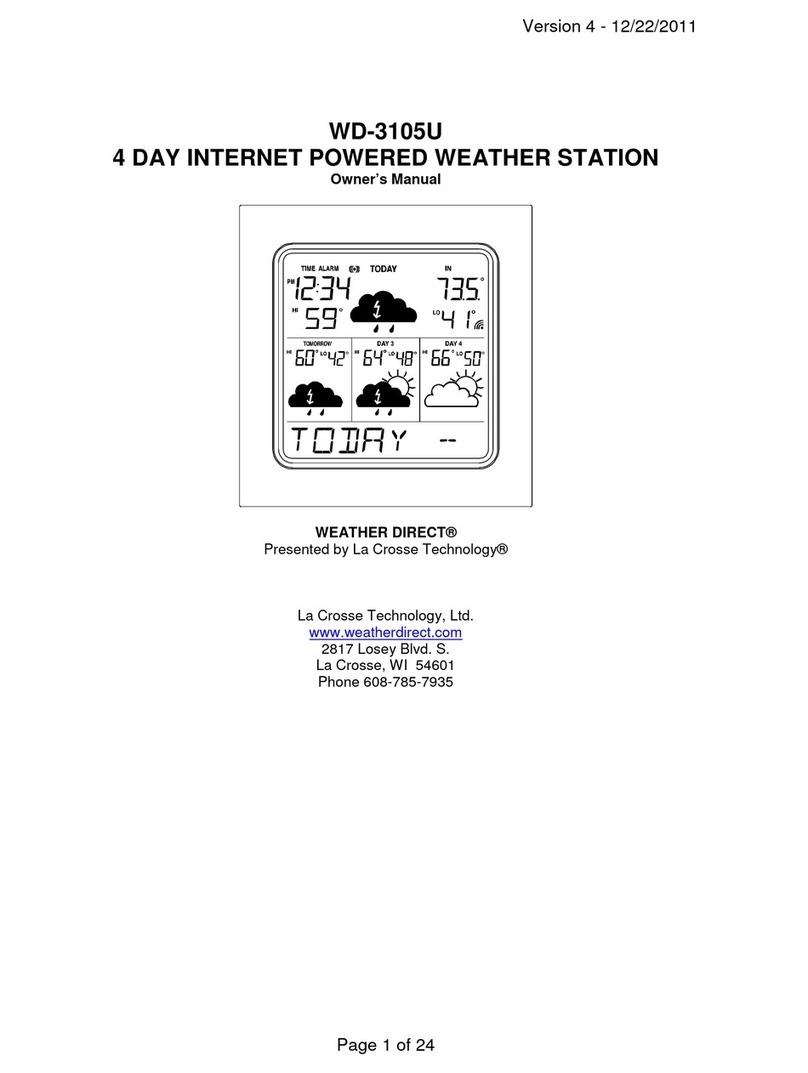
La Crosse Technology
La Crosse Technology WEATHER DIRECT WD-3105U owner's manual

Braun
Braun BNC013-RC User instructions
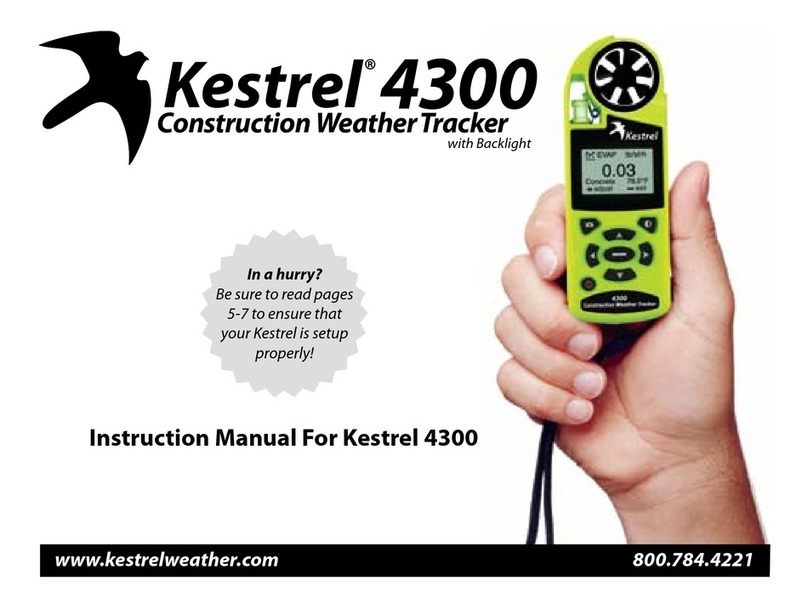
Nielsen-Kellerman
Nielsen-Kellerman Kestrel 4300 instruction manual
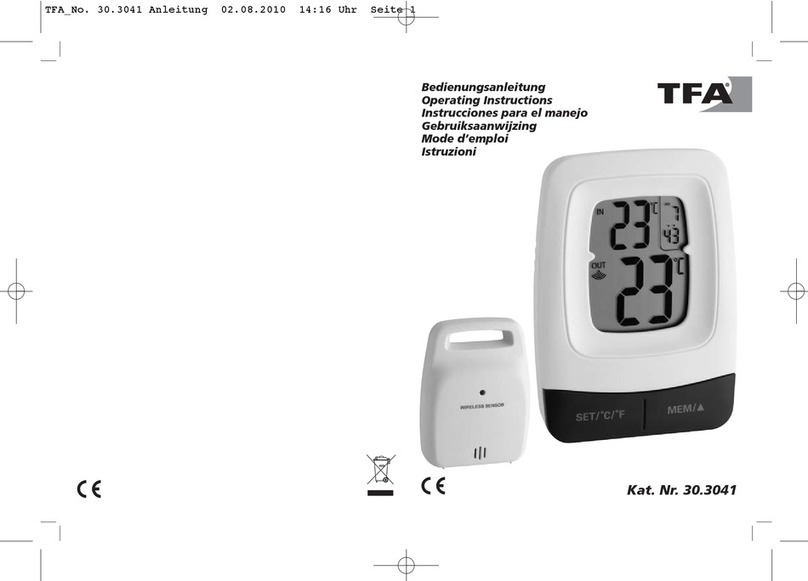
TFA
TFA 30.3041 operating instructions
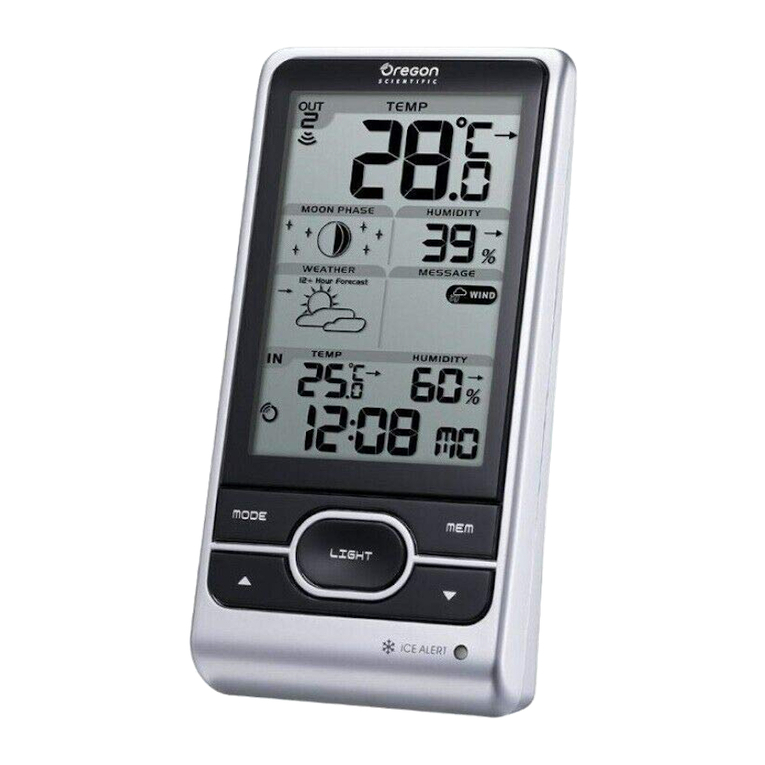
Oregon Scientific
Oregon Scientific BAR208HGA user manual
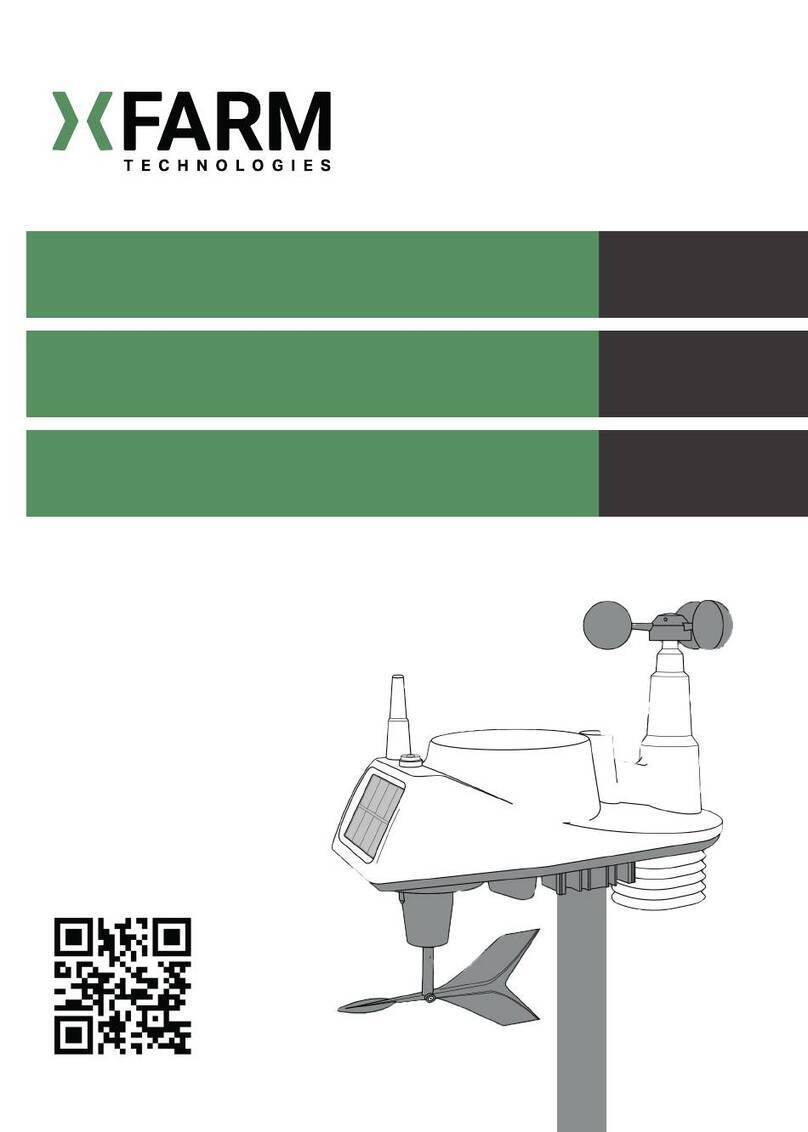
XFARM
XFARM xSense Mini Quick Guide to installation and use

La Crosse Technology
La Crosse Technology WS9132 instruction manual
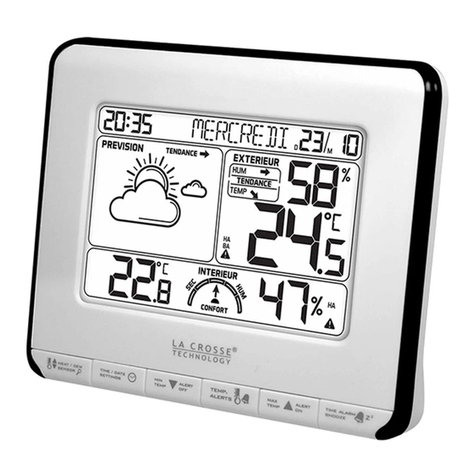
La Crosse Technology
La Crosse Technology WS6818 Quick setup guide

Hyundai
Hyundai WS 1855 instruction manual

WEATHER DIRECT
WEATHER DIRECT WD-2512U owner's manual


